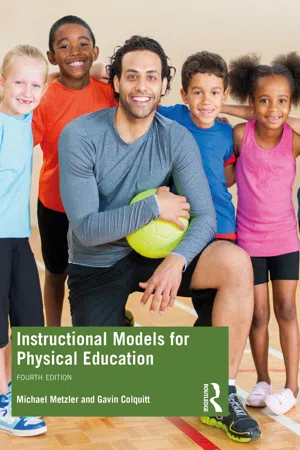
Instructional Models for Physical Education
- 448 pages
- English
- ePUB (mobile friendly)
- Available on iOS & Android
Instructional Models for Physical Education
About this book
No single instructional method can meet all of the student learning needs expressed in the SHAPE America National Standards for Physical Education. This new edition provides pedagogical knowledge and resources that support physical education teachers' selection and use of instructional models and gives physical educators a plan for incorporating these models into their teaching.
Presented in two sections, Instructional Models for Physical Education 4E first presents the rationale, pedagogical knowledge, and selection processes for Model-Based Instruction (MBI). MBI is the commitment to use one instructional plan throughout a unit of instruction. The second section provides pedagogical knowledge for the selection, implementation and assessment of instructional models used in P–12 physical education.
This edition has been updated to be in alignment with the SHAPE America National Standards for Physical Education. It includes new sections on differentiated instruction and practical applications. A companion website contains additional examples and information for each model.
The book includes everything the reader needs for planning, implementing, and assessing when teaching with instructional models. It helps readers incorporate research-based practices in their lessons, adapt activities, and teach to standards. This text can be used as the stand-alone text for courses on physical education teaching methods at the undergraduate and graduate levels.
Frequently asked questions
- Essential is ideal for learners and professionals who enjoy exploring a wide range of subjects. Access the Essential Library with 800,000+ trusted titles and best-sellers across business, personal growth, and the humanities. Includes unlimited reading time and Standard Read Aloud voice.
- Complete: Perfect for advanced learners and researchers needing full, unrestricted access. Unlock 1.4M+ books across hundreds of subjects, including academic and specialized titles. The Complete Plan also includes advanced features like Premium Read Aloud and Research Assistant.
Please note we cannot support devices running on iOS 13 and Android 7 or earlier. Learn more about using the app.
Information
PART I
Chapter 1
Standards for Physical Education
Standard 1: | The physically literate individual demonstrates competency in a variety of motor skills and movement patterns. |
Standard 2: | The physically literate individual applies knowledge of concepts, principles, strategies and tactics related to movement and performance. |
Standard 3: | The physically literate individual demonstrates the knowledge and skills to achieve and maintain a health-enhancing level of physical activity and fitness. |
Standard 4: | The physically literate individual exhibits responsible personal and social behavior that respects self and others. |
Standard 5: | The physically literate individual recognizes the value of physical activity for health, enjoyment, challenge, self-expression and/or social interaction. |
Program Alignment to Achieve the National Standards
- Program goals and design;
- Curriculum models;
- Instructional models.
Program Goals and Design
Curriculum Models
- clearly specify which of the national standards they are attempting to promote;
- show an intentional process for deciding which content units should be offered in the program;
- determine which resources are needed to help students achieve the major learning outcomes; and
- regularly assess the major outcomes as well as the curriculum plan itself.
Table of contents
- Cover
- Half Title
- Title Page
- Copyright Page
- Dedication
- Table of Contents
- List of Exhibits
- Part I Foundations for Model-Based Instruction in Physical Education
- Part II Eight Instructional Models for Physical Education
- References
- Index